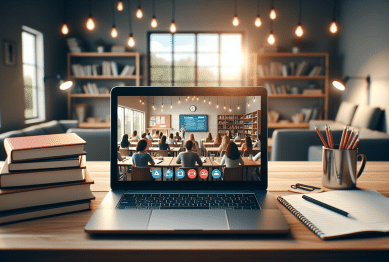Remote learning is reshaping education, offering access, flexibility, and diverse opportunities. This article explores how online classrooms, virtual resources, and new digital skills are changing what you can expect from modern education.
Changes Remote Learning Brings to the Classroom
Remote learning challenges the traditional classroom environment, creating fresh pathways to educational content. The introduction of digital platforms means that geographic boundaries become less relevant when it comes to accessing courses and instructors. Platforms using virtual classrooms open doors for learners regardless of their location. This is especially important in regions with limited access to physical schools or higher learning institutions. The move to online teaching technologies has necessitated new skill sets for both learners and teachers, making digital literacy an essential educational component (see https://ed.stanford.edu/news/technology-and-learning).
With the evolution of online learning, students are noticing different rhythms to their day. Instead of rigid schedules, virtual classroom systems let learners choose how and when to study. For some, this means staying up late to work through complex ideas or revisiting recorded lessons for better understanding. These adjustments can reduce anxiety and help students build better habits, as they are encouraged to develop time management skills and independent study routines.
The changes brought on by remote education are not only about logistics or convenience. They also involve the ways students and teachers interact. Online forums, live discussions, and collaborative digital spaces offer fresh opportunities to connect, but they also present challenges like digital fatigue and the need for clearer communication. Still, many find these new channels enable more inclusive participation, especially for quieter students who might not speak up in a traditional classroom setting.
Accessibility and Equity in Digital Classrooms
One major promise of remote learning lies in its potential to improve educational equity. Online platforms make it easier for students from diverse backgrounds to access resources that might otherwise be out of reach. A rural student can study advanced science through remote instruction while a busy parent looking to change careers may join courses after work hours. These opportunities are helping bridge some long-standing inequities in the education system (see https://www.ed.gov/news/press-releases/advancing-equity-through-technology).
However, the digital divide remains a pressing challenge. Reliable internet connections, adequate devices, and digital training are not available to everyone. Many schools and nonprofit organizations are working to close these gaps by supplying devices and hotspots or running local tech-literacy programs. Investments in public libraries and free Wi-Fi in communities often support those who would be left behind by the shift to virtual learning.
Accessibility design in online learning also includes resources for students with disabilities. From closed captions on videos to screen-reader-friendly websites, technology offers tools that help more learners participate fully. Making sure these features are standard, not optional, is an ongoing issue in building an equitable education environment (see https://nces.ed.gov/fastfacts/display.asp?id=60).
How Digital Skills Shape Modern Education
Remote learning relies on digital skills for every level of participation and achievement. The ability to comfortably navigate a learning management system or troubleshoot a video call is now fundamental—not just optional. Many school systems incorporate coding modules and digital citizenship courses to help ease this transition, aiming to ensure no learner gets left behind due to lack of tech know-how. These tools have become as necessary as old-fashioned notebooks once were (see https://www.edsurge.com/news/why-digital-literacy-matters).
Digital skills also prepare students for an evolving workforce. From cloud computing to collaboration tools, modern work often requires comfort with technology in addition to subject-area expertise. Students who gain experience in virtual classrooms or group projects often find these skills directly transfer to internships and future careers, giving them confidence in the job market. The value of these capabilities should not be underestimated in today’s competitive environment.
Beyond core digital competencies, soft skills like online etiquette and personal responsibility become more prominent when learning virtually. Navigating digital discussions, sending respectful emails, and interpreting tone online take practice. These habits can carry forward into work and social life, underscoring the broad impact of digital learning environments on students’ long-term development.
The Social Impact of Remote Learning on Students
Some worry that remote learning means social isolation, but a closer look reveals a more nuanced reality. Virtual classrooms can foster surprisingly strong communities, especially when instructors actively cultivate thoughtful discussion and collaborative projects. Small groups formed online sometimes prove more inclusive than face-to-face classes. Peer-to-peer learning benefits as students from different places and backgrounds collaborate on diverse projects (see https://www.edutopia.org/article/ways-online-learning-promotes-social-skills).
Of course, remote learning does introduce challenges around social engagement. Spontaneous hallway chats and after-class conversations are less common. Some students miss these unstructured moments where friendships form. Virtual clubs, discussion forums, and extracurricular meetings can partly fill this space, but replicating the casual social life of campus remains an ongoing experiment. Encouragingly, some learners enjoy the flexibility to participate in global interest groups that would have been unavailable locally.
Social-emotional learning is another factor in remote education. Schools recognize that emotional well-being and mental health are closely tied to academic performance. More institutions now include online counseling, wellness workshops, and regular check-ins to address potential isolation and stress. These supports are critical for helping students adapt and thrive in new digital spaces.
Parent and Teacher Roles in Supporting Remote Students
The shift to digital classrooms has redefined what it means to support learners at home and at school. For parents, this can involve creating quiet learning spaces, troubleshooting tech issues, or simply encouraging independent study. Many have found themselves learning alongside their children, discovering configuration tricks or helpful apps together. The partnership between caregiver and student can grow stronger in this environment (see https://www.commonsense.org/education/articles/help-parents-manage-remote-learning).
Teachers, meanwhile, have expanded their roles to include instructional design, digital troubleshooting, and often personalized outreach. Creating engaging lessons on screen versus in person is a skill that demands creativity, patience, and adaptability. Teachers may experiment with gamification, multimedia content, or breakout groups to maintain participation and excitement amid digital fatigue.
This changing support landscape has encouraged professional development programs for educators, with workshops focused on online pedagogy and student engagement. These resources help teachers respond to emerging challenges and sustain vibrant, effective remote classrooms. The ongoing evolution of teacher and parent involvement continues to shape the trajectory of remote learning for all involved.
Long-Term Considerations and the Future of Learning
Will remote learning replace traditional classrooms? Most experts see a future where blended or hybrid models become the standard. This approach combines the flexibility and resource-rich environment of online education with the face-to-face interaction and socializing found in physical classrooms. The exact proportion may vary, depending on community needs and resources, but the trajectory toward digital integration seems clear (see https://www.brookings.edu/articles/remote-learning-in-education-what-happens-next/).
One important consideration moving forward is continuous adaptation. The digital education landscape changes rapidly, so learners, parents, and schools must remain open to shifts in platforms, curriculum design, and assessment methods. Feedback from students and experiments with new technologies play crucial roles in shaping what comes next. Ongoing evaluation and research ensure that practices stay inclusive and effective.
The story of remote education is still being written. Technological advancements, societal needs, and creative learners will continue to push boundaries. As each challenge emerges—whether it’s a new app, a gap in access, or a changing workforce need—teachers, parents, and students are finding creative ways to address it collectively. This fluid, adaptable approach could lead to educational experiences that are more inclusive and effective for everyone.
References
1. Stanford Graduate School of Education. (n.d.). Technology and learning. Retrieved from https://ed.stanford.edu/news/technology-and-learning
2. U.S. Department of Education. (n.d.). Advancing equity through technology. Retrieved from https://www.ed.gov/news/press-releases/advancing-equity-through-technology
3. National Center for Education Statistics. (n.d.). Children and youth with disabilities. Retrieved from https://nces.ed.gov/fastfacts/display.asp?id=60
4. EdSurge. (n.d.). Why digital literacy matters. Retrieved from https://www.edsurge.com/news/why-digital-literacy-matters
5. Edutopia. (n.d.). Ways online learning promotes social skills. Retrieved from https://www.edutopia.org/article/ways-online-learning-promotes-social-skills
6. Common Sense Education. (n.d.). Help parents manage remote learning. Retrieved from https://www.commonsense.org/education/articles/help-parents-manage-remote-learning









